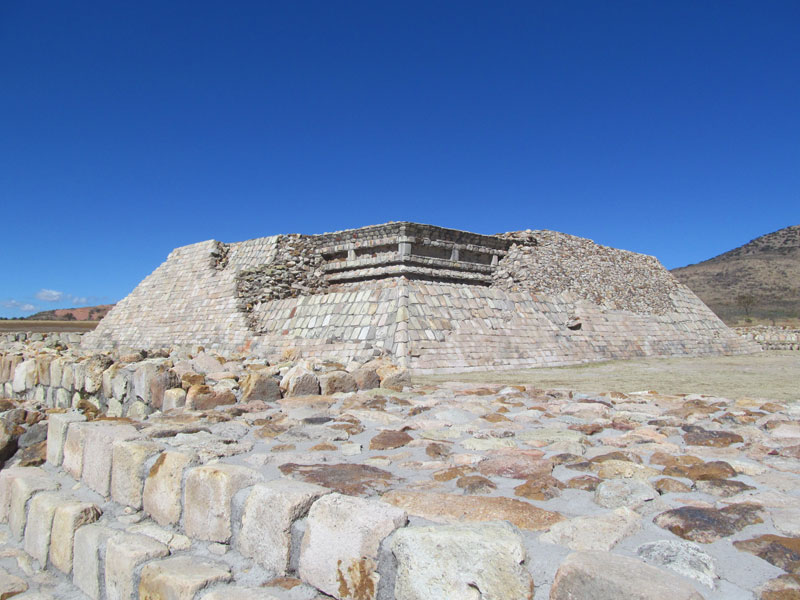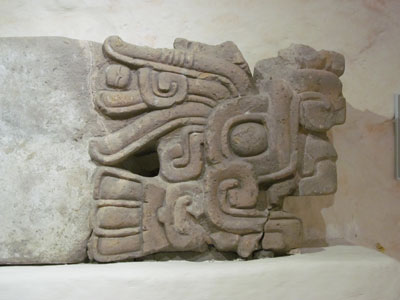Pre-Columbian Bajío region cities
This item appears on page 53 of the December 2015 issue.
(Part 2 of 3 on central Mexico)
Having just visited La Cañada de la Virgen, considered the main archaeological site in the Bajío region of central Mexico, my husband, Paul, and I decided we wanted to see more pre-Columbian sites.
The Bajío is not generally known for its archaeological sites. In fact, most books on Mexico that I looked at skip this region of Mexico entirely when discussing Mesoamerican archaeology. Yet there are hundreds of sites — most only recently explored and/or excavated — in the Bajío region, including the four major sites of La Cañada de la Virgen, Plazuelas, Peralta and El Cóporo.
A guide at La Cañada de la Virgen called the earliest people to occupy this region “the Bajío people.” Dominating this area of Mexico from about 800 BC to AD 900, they were a regional cultural group distinct from other Mesoamerican groups with more familiar names, such as the Maya, Zapotecs or Teotihuacán people, all of whom flourished at more or less the same time as the Bajío people.
The Bajío people built the patios, platforms and pyramids we had seen at La Cañada and which we were to visit at Plazuelas and Peralta.
Plazuelas
From San Miguel de Allende, the beautiful colonial city where Paul and I were based from mid-January to mid-February 2015, it’s a 2-hour drive of 104 miles southwest to Plazuelas. The main archaeological group at Plazuelas is located south of the Sierra de Pénjamo mountain range, with steep ravines bordering two sides of the site.
As you enter the site, there is a large ball court in the shape of a capital letter “i,” with slanting walls for the leather balls to bounce off of that were used in the ritual game.
In the four corners of this ball court were found serpent sculptures, a few of which are displayed in the on-site museum. Close to the ball court is a temazcal, which was the ceremonial bathhouse for the ball players.
Las Casas Tapadas
Beyond the ball court lies an immense stone platform, 490 feet by 290 feet, with three pyramids on top. The shapes of the pyramids mimic perfectly the shapes of the three hills in the distance.
Collectively called Las Casas Tapadas, the pyramids once had a temple on top of each. Found there, torn down from their original locations on the pyramids and temples, were stone shell designs that represented the wind, as well as stone lightning bolts representing rain and Tlaloc, the god of rain.
There was probably a war in which the temples on top of the pyramids were destroyed and their decorative embellishments removed and thrown down.
What is known is that Plazuelas was abandoned around AD 900. Whether it was war or prolonged drought that drove the original inhabitants away is not known. A seminomadic group, the Chichimecs, migrated there afterward, reoccupying the site but building no pyramids of their own.
What is unique about Plazuelas are the hundreds of petroglyphs found throughout the site — high- and low-relief circles, spirals, zoomorphic figures and dotted lines. There is one wonderful example near the ball court, a rock engraving that’s a diagram of the platform with the pyramids on top, a “floor plan” of the site.
You can see photographs of some of the other engravings in the on-site museum as well as stone serpents, shells and lightning bolts. There’s also a collection of exquisite tiny, green, stone figurines that were found on this site.
Peralta
The second archaeological site we visited, Peralta, is a 34-mile drive northeast on the way back to San Miguel de Allende. Like Plazuelas, Peralta was built by the Bajío peoples, flourished between AD 300 and 900 and was abandoned after 900. As at Plazuelas, Chichimecs settled on the site afterward.
Despite these similarities between the two sites, it is not known what relationship Plazuelas had to Peralta, whether they were equal neighbors and/or partners or one was subservient to the other. Since both were on the trading route between northern and western Mexico and groups south and east, it is safe to assume that they traded with each other.
Only a small portion of the site has been excavated. A 15-minute walk from the entrance leads to two pyramids at right angles to each other, with a sunken patio joining them and with a raised walkway above the patio. There are access stairs up to the walkway overlooking the patio as well as stairs leading down into the patio. We had not seen anything similar at any other archaeological site in Mexico.
Unique round platform
A 10-minute walk away is another unusual structure, the Governor’s Precinct. It’s an immense, 480-by-450-foot, rectangular stepped construction with only one entrance leading into a sunken patio.
On one of the sides overlooking the patio is a round platform with a smaller sunken patio at its side. It was on this platform that ceremonies honoring the wind and rain gods probably were performed, with spectators gathered in the patio below.
It is also speculated that the houses of the priests who performed the ceremonies once may have occupied portions of the patio. There’s a small on-site museum.
From Peralta, it’s 80 miles back to San Miguel de Allende.
If you go…
Visiting both Plazuelas and Peralta is a long one-day excursion — estimating 4 to 4½ hours of driving, 1½ hours at each site and a one-hour lunch break — so it’s wise to make an early start. It’s also wise to consider hiring someone to either drive and guide or to just drive.
We had toured with Angelica Transportation & Tours (San Miguel de Allende; phone 011 52 415 152 6305 or visit www.vivasanmiguel.com [look under “San Miguel Businesses” and click on “Taxi/Transportation” or on “Tours & Guides”]) on another excursion and were so pleased with that trip that we decided to go with them again to Plazuelas and Peralta.
The cost for a driver, with no guide, was $30 per hour for a total of $255 for the day, not including tip. F
Coming up — Julie describes the Bajío site of El Cerrito, near Santiago de Querétaro.


